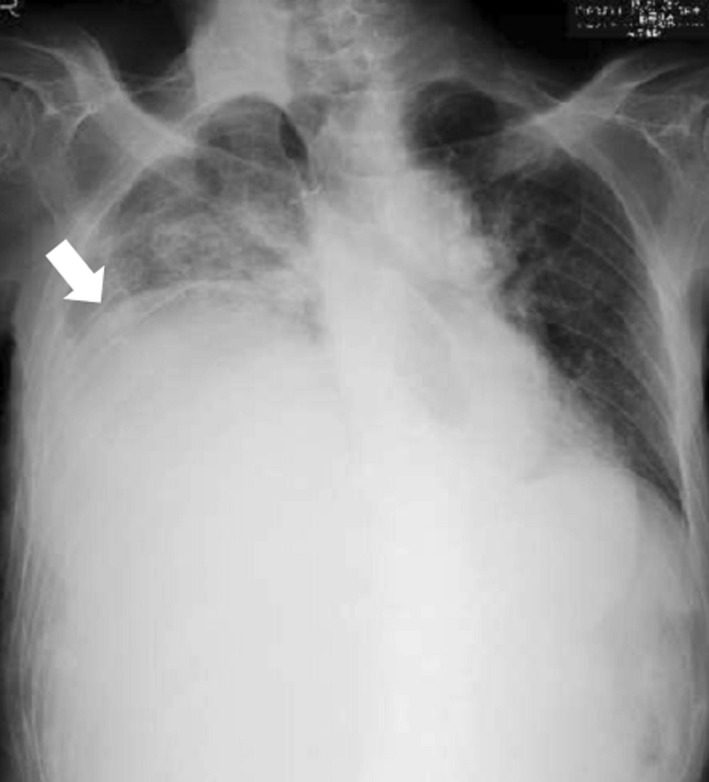Abstract
Hepatic cysts usually do not cause symptoms and may be detected incidentally on abdominal imaging. However, a giant hepatic cyst can rarely compress the inferior vena cava, right lung, and spine, leading to edema of lower extremities and scoliosis.
Keywords: endoscopy, huge cyst
Hepatic cysts usually do not cause symptoms and may be detected incidentally on abdominal imaging. However, a giant hepatic cyst can rarely compress the inferior vena cava, right lung, and spine, leading to edema of lower extremities and scoliosis.

Question
What is this condition?
Answer
A giant hepatic cyst compresses the inferior vena cava, right lung, and spine, leading to spinal curvature toward the left.
1. CASE PRESENTATION
We present the case of an 89‐year‐old man with a giant hepatic cyst that was compressing the inferior vena cava, right lung, and spine. This resulted in the curvature of the spine to the left, difficulty in ambulation, and edema of the lower extremities.
Over several years, an 89‐year‐old Japanese man had experienced edema of the lower extremities, recurrent abdominal pain, and difficulty in breathing and walking. The physical examination showed poor posture, reduced breath sounds in the basal right hemithorax, and an asymmetrically enlarged abdomen because of a palpable mass in the right upper quadrant that extended below the umbilicus. The chest radiograph revealed an elevated right hemidiaphragm (Figure 1). Computed tomography revealed a giant hepatic cyst (Figure 2). Resection was recommended; however, the patient declined to undergo surgery.
FIGURE 1.

Anterior‐posterior chest radiograph demonstrating elevated right hemidiaphragm compressing the right lung (arrow)
FIGURE 2.

Noncontrast computed tomography of the chest in the coronal view demonstrating a giant large hepatic cyst (arrow). The pressure exerted by the cyst resulted in the curvature of the spine toward the left
2. DISCUSSION
Hepatic cysts usually do not cause symptoms and may be detected incidentally during abdominal imaging. 1 However, they may cause pain in the right upper quadrant. When these cysts compress on the surrounding organs, symptoms including portal hypertension and jaundice may develop. 2 In this case, compression of the inferior vena cava caused edema of the lower extremities. The cyst also compressed the patient's right lung and resulted in the spine curving to the left. In such cases, surgical resection is usually recommended because of the challenge in accurately diagnosing the cyst as benign.
CONFLICT OF INTEREST
None declared.
AUTHOR CONTRIBUTIONS
IH and KD: contributed to patient management. IH: drafted the initial manuscript. RI: critically reviewed manuscript. All authors: contributed to writing the manuscript and provided written consent for publication.
ETHICAL APPROVAL
Written informed consent was obtained from the patient for publication of this case report and any accompanying images.
Hirayama I, Inokuchi R, Fukue M, Doi K. Giant hepatic cyst causing lower extremity edema and scoliosis. Clin Case Rep. 2021;9:2483–2484. 10.1002/ccr3.3951
DATA AVAILABILITY STATEMENT
The data that support the findings of this study are available from the corresponding author upon reasonable request.
REFERENCES
- 1. Sato T, Imai M, Hayashi K, et al. Giant hepatic cyst with septal structure: diagnosis and management. Int J Hepatol. 2013;2013:981975. [DOI] [PMC free article] [PubMed] [Google Scholar]
- 2. Asuquo M, Nwagbara V, Agbor C, et al. Giant simple hepatic cyst: a case report and review of relevant literature. Afr Health Sci. 2015;15:293‐298. [DOI] [PMC free article] [PubMed] [Google Scholar]
Associated Data
This section collects any data citations, data availability statements, or supplementary materials included in this article.
Data Availability Statement
The data that support the findings of this study are available from the corresponding author upon reasonable request.


